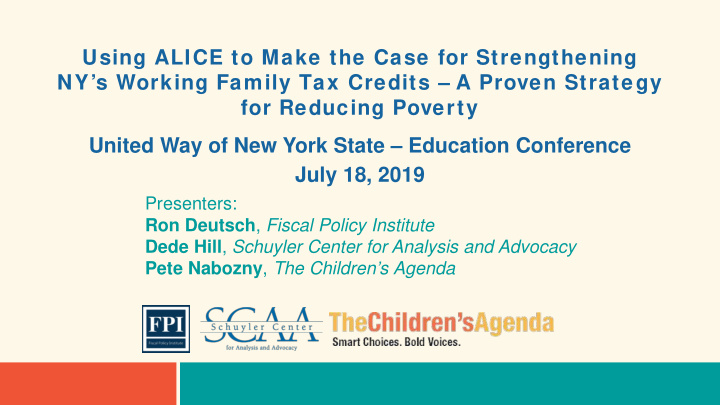



Using ALICE to Make the Case for Strengthening NY’s Working Family Tax Credits – A Proven Strategy for Reducing Poverty United Way of New York State – Education Conference July 18, 2019 Presenters: Ron Deutsch , Fiscal Policy Institute Dede Hill , Schuyler Center for Analysis and Advocacy Pete Nabozny , The Children’s Agenda
How much do families need to make ends meet? 1
Federal Poverty Guidelines 2019 2 1 $12,490 2 $16,910 3 $21,330 4 $25,750 5 $30,170 Formula developed in the 1960’s and assumes 1/3 of a families budget is for food. Many programs use 200% of FPL to determine eligibility – WHY?
ALICE lives in New York! 3
NYS ALICE Household Survival Budget 4
Child Poverty in NYS it TOO High 5
Due to structural racism, poverty disproportionately threatens the well-being of Black and Latino NY children 6
ALICE the Advocate? 7 How should I use ALICE? ALICE goes to Albany….. ALICE fights for Working Family Tax Credits ALICE is a useful tool
Children growing up in poverty are more likely to experience adversity, which can compromise health 8
Reports of child neglect far outweigh those of abuse 9 In 2016, more than 71,000 children were involved in indicated reports of abuse/neglect
Hard work no longer guarantees economic security for NY families
Quality child care enables parents to work, and provides children early learning opportunities – but high costs are a barrier 11 bullet bullet
Refundable tax credits encourage work, help make paychecks stretch further, and reduce poverty 12 The federal EITC and CTC, lifted 9.4 million people out of poverty in 2013, including 5 million children, and made 22 million other people less poor.
New York’s working family tax credits help make paychecks stretch further, but exclude some of those who could benefit the most 13
Our Vision for New York State 14 New York State is the best place in the country to raise a family All families in our state have the financial resources to support their children All children in our state are supported and able to achieve their full potential New York State’s tax policy should be designed to support low-income & ALICE families
Our Proposal for New York State 15 Expand and strengthen the Earned Income Tax Credit Expand the state’s match from 30% to 45% of the federal program Extend the EITC to childless workers under age 25 Expand and strengthen the Empire State Child Credit Extend the credit to children under age 4 Double the credit for young children Reform the structure of the EITC Allow quarterly payments option Make available to more immigrant New Yorkers
Expand the state’s match from 30% to 45% 16 New York State's EITC has not increased in 16 years 30% 28% 25% 23% 20% 10% 8%
Expand the state’s match from 30% to 45% 17 Current and Proposed State EITC, Single Parent with 1 Dependent $1,800 $1,557 $1,600 $1,400 $1,200 $1,038 $1,000 $800 $600 $400 $200 $0 30% State EITC 45% State EITC
Close the EITC Young Adult Worker Loophole 18 Childless adult workers under 25 are currently excluded from the EITC Young adults are more likely to be in poverty than any other adult Starting their careers – need to build attachment to labor market 20% of births are to mothers under 25 years old Extend the state EITC to non-dependent workers under 25 NYS assumes the federal share Average credit of $469
Improve the Empire State Child Credit 19 Empire State Child Credit Today Fully refundable Provides up to $330 per child Excludes children under 4 Phases out at $75,000 (single parent) and $110,000 (married couple) Proposed improvements Close the early childhood loophole Double the credit for young children
The Cost Question 20 Effective anti-poverty policies require significant public investment These tax credits are an economic stimulus Cost Estimates Increasing state match to 45% - $540 million per year Closing young adult EITC loophole - $41 million per year Closing early childhood ESCC loophole - $195 million per year Doubling for young children – additional $195 million per year Total Investment - $971 million
Allow Quarterly EITC Payment 21 Current law – lump sum EITC payment with tax return Proposal – give EITC recipients the option to receive up to 60% of state EITC in advance through 3 quarterly payments throughout the year Checks issued by NYS Tax and Finance Reconciled through income tax return process Safeguards to prevent workers from owing NYS money
Existing EITC Payment Structure 22 Wage Earnings and EITC Income (at 45% Match), Single Parent with One Child Making $18,500 per year $7,000 $1,557 $6,000 $5,000 $4,000 $3,000 $2,000 $1,000 $0 January February March April May June July August September October November December Wage Earnings Federal EITC State EITC (45% Match)
Proposed Quarterly EITC Payment Structure 23 Proposed Wage Earnings and EITC Income (at 45% Match), Parent with One Child Making $18,500 $7,000 $6,000 $623 $5,000 $4,000 $3,000 $311 $311 $311 $2,000 $1,000 $0 January February March April May June July August September October November December Wage Earnings Federal EITC State EITC (45% Match)
Allow Immigrant Families to Access Tax Credits 24 NYS law currently follows the federal program and requires a Social Security Number to receive the EITC Non-citizens use an Individual Tax Identification Number (ITIN) to file their taxes The EITC is designed to benefit households with children New York State should modify state law to allow taxpayers who file with an ITIN to access the state EITC
Conclusion 25 Tax policy should be central to our discussions about how to reduce poverty and support ALICE households Working family tax credits are highly effective ways to improve the lives of families throughout New York State New York State has the opportunity to once again lead the nation in this space Advocates for improved tax policy are needed in all corners of New York State
Recommend
More recommend